Jan 08, 2026
Jan 08, 2026
The 1960s – The Golden Years – Part 13
Notable Films (1965-1968) Continued
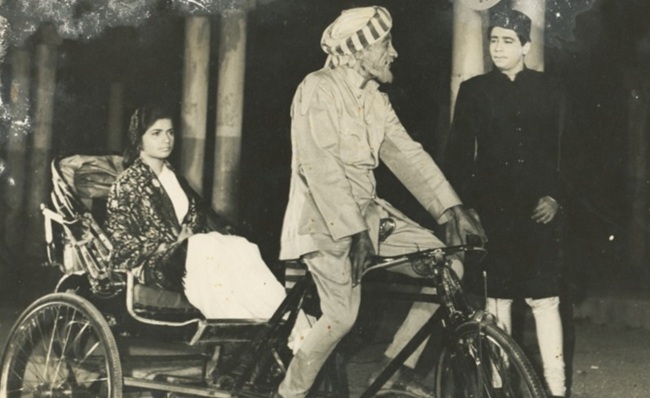 Aasman Mahal, produced and directed by KA Abbas from a script by Inder Raj Anand, is the story of an aging Nawab (Prithviraj Kapoor) in post independence India, whose ancestors have left him with debts, the ownership of a palace called Aasman Mahal, and the burden of maintaining the family’s prestige even in his impoverished state. Offered the choice of selling the palace for the buyer to convert it into a hotel, or of migrating to Pakistan where, he is told, he will be welcomed with open arms, he rejects both offers in the vain hope of finding the money to clear his debts. He spends much time browsing through the family album, and knocking at the stone walls and floors of the palace, searching for hidden treasure, which one of his ancestors was said to have buried in the palace. His rebellious son Salim (Dilip Raj) wants to marry Salma (Surekha), the daughter of the Nawab’s former syce Ghulam Rasool (Nana Palsikar), instead of Suraiya, the daughter of Niaz Jung, his old friend of a similar rank.
Aasman Mahal, produced and directed by KA Abbas from a script by Inder Raj Anand, is the story of an aging Nawab (Prithviraj Kapoor) in post independence India, whose ancestors have left him with debts, the ownership of a palace called Aasman Mahal, and the burden of maintaining the family’s prestige even in his impoverished state. Offered the choice of selling the palace for the buyer to convert it into a hotel, or of migrating to Pakistan where, he is told, he will be welcomed with open arms, he rejects both offers in the vain hope of finding the money to clear his debts. He spends much time browsing through the family album, and knocking at the stone walls and floors of the palace, searching for hidden treasure, which one of his ancestors was said to have buried in the palace. His rebellious son Salim (Dilip Raj) wants to marry Salma (Surekha), the daughter of the Nawab’s former syce Ghulam Rasool (Nana Palsikar), instead of Suraiya, the daughter of Niaz Jung, his old friend of a similar rank.
Ghulam Rasool, the syce, bereft of horses and carriages, and without his salary, which the old, ailing Nawab can no longer afford, plies a rickshaw to support himself and his daughter.
The story, and KA Abbas’s direction make Aasman Mahal a thought-provoking, memorable film, different from the run-of-the-mill Hindi films. In one of the best performances I have seen from Prithviraj Kapoor, he lives the role of the impoverished Nawab. Dilip Raj, Surekha, Nana Palsikar, and David play their roles to perfection. The film was shot, not on studio-built sets, but entirely in the authentic location of Aasman Mahal, a palace in the Lakdi ka pul area of Hyderabad city. Prithviraj Kapoor's acting won him a special Honor at the Karlovy Vary film festival.
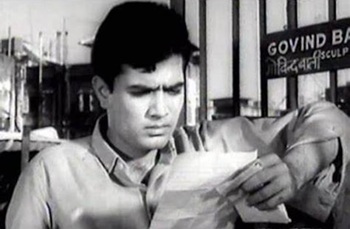 Akhri Khat, written and directed by Chetan Anand, is about a fifteen-month-old infant searching for his mother in Bombay. Coming from Kullu in search of her husband, she dies of a congenital disease, leaving a last missive to accept his child. The child Buntu is played by the cute, curly-haired and chubby Bunty, who cannot speak, except for a lispy ‘Mamma’. Each time he utters the word, viewers reach for their hankies to wipe their tears.
Akhri Khat, written and directed by Chetan Anand, is about a fifteen-month-old infant searching for his mother in Bombay. Coming from Kullu in search of her husband, she dies of a congenital disease, leaving a last missive to accept his child. The child Buntu is played by the cute, curly-haired and chubby Bunty, who cannot speak, except for a lispy ‘Mamma’. Each time he utters the word, viewers reach for their hankies to wipe their tears.
Chetan Anand let the child loose in the city, following him with a handheld camera, and cinematographer Jal Mistry. With such a small, helpless child as the main character, Chetan Anand weaves a script sans melodrama, with all the people in the film looking authentic. Rajesh Khanna, making his debut, recalled how Chetan Anand left him sleepless with repeated phone calls to ensure that his face displayed the pathos he wanted. Music director Khayyam gave some remarkable tunes, of which the most popular was Baharon mera jeevan bhi sanwaro, sung by Lata Mangeshkar. Bhupendra made his debut strumming a guitar as he sang Rut jawan jawan.
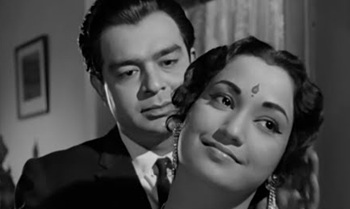 Anupama, directed by Hrishikesh Mukherjee, was the story of a child neglected by her alcoholic father because her mother died after giving birth to her. Under her father’s domination, Uma (Sharmila Tagore) grows up as a timid, introverted, and inarticulate person. She approaches adolescence with wonder, as she notices the changes in nature at the advent of spring. Her heart responds when she meets Ashok, a straightforward and outspoken teacher and writer, who defies societal restrictions, unmindful of the financial difficulties he must face. She does not reveal her feelings for fear of her father. Ashok, who believes in women’s emancipation, does not want to speak on her behalf because he cannot cage her like her father did for all these years. Ashok writes a book inspired by her life, and Uma gathers the courage to confront her father after reading it.
Anupama, directed by Hrishikesh Mukherjee, was the story of a child neglected by her alcoholic father because her mother died after giving birth to her. Under her father’s domination, Uma (Sharmila Tagore) grows up as a timid, introverted, and inarticulate person. She approaches adolescence with wonder, as she notices the changes in nature at the advent of spring. Her heart responds when she meets Ashok, a straightforward and outspoken teacher and writer, who defies societal restrictions, unmindful of the financial difficulties he must face. She does not reveal her feelings for fear of her father. Ashok, who believes in women’s emancipation, does not want to speak on her behalf because he cannot cage her like her father did for all these years. Ashok writes a book inspired by her life, and Uma gathers the courage to confront her father after reading it.
Sensitive performances by Dharmendra and Sharmila Tagore, whose silences and glances are more eloquent than their dialogues, and Hrishikesh Mukherjee’s crisp direction make the film notable. After her forays into frivolous romancing in Kashmir Ki Kali and Waqt, it was refreshing to see her perform as we had seen her in her early Bengali films, Satyajit Ray’s Apur Sansar and Devi. In Aradhana, you see her eyes shrieking for help, but at the same time, subdued. The other characters ably support the main theme. The bubbly, extroverted character played by Shashikala is deliberately overplayed to counterbalance the character of Uma.
Hemant Kumar’s tunes Dheere dheere machal and aisi bhi baaten hoti hain sung by Lata Mangeshkar, and Ya dil ki suno sung by Hemant Kumar are unforgettable.
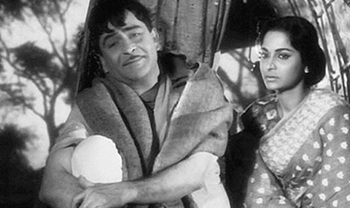 Teesri Kasam was the only film produced by lyricist Shailendra. It was based on a Hindi short story titled Mare Gaye Gulfam, by Phanishwar Nath Renu, with a screenplay by Nabendu Ghosh, well known for writing the screenplays for Bimal Roy’s films. Satyajit Ray’s cinematographer Subrata Mitra wielded the camera.
Teesri Kasam was the only film produced by lyricist Shailendra. It was based on a Hindi short story titled Mare Gaye Gulfam, by Phanishwar Nath Renu, with a screenplay by Nabendu Ghosh, well known for writing the screenplays for Bimal Roy’s films. Satyajit Ray’s cinematographer Subrata Mitra wielded the camera.
Teesri Kasam is the story of a bullock cart driver who got into trouble earlier for carrying smuggled goods and bamboo. He made two vows never to carry such things. He is asked to take a nautanki dancer to a village fair. Unaware of her profession, he finds her attractive and falls in love with her. She likes his simplicity, and they travel together happily. At the fair, he comes to know that she is a prostitute and tries in vain to make her change. When she parts from him saying that she has been sold to a rich man, he is disappointed, and makes his third vow, never to carry a nautanki woman.
Basu Bhattacharya directed the film with a sense of realism, asking Raj Kapoor to shed his mannerisms. Raj Kapoor charged only one rupee for the film and advised Shailendra to add some commercial elements to the film. All the songs are memorable: Duniya banane wale sung by Mukesh, Mare gaye gulfam sung by Lata Mangeshkar, and Preet banake tu ne sung by Suman Kalyanpur, Aa aa bhi jaa sung by Lata Mangeshkar, Chalat Musafir by Manna Dey, Haye ghazab kahin tara toota, Paan khaye sainya hamaro, and Lali lali doliya mein sung by Asha Bhonsle and Mukesh’s solos Sajanwa bairi ho gaye and Sajan re jhoot mat bolo.
Teesri Kasam was well received by critics and won the National Film Award for Best Feature Film in 1967. However, it proved to be a commercial failure at the box office. Shailendra invested heavily in the production of the movie, which took many years to complete. Tensions associated with film production and anxiety due to financial loss ultimately led to his early demise on 14 December 1966.
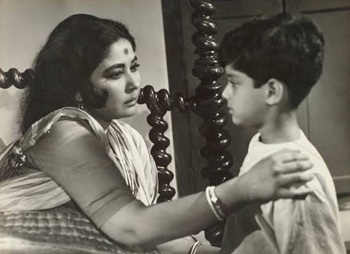 Majhli Didi is Hrishikesh Mukherjee’s interpretation of Sarat Chandra Chatterjee’s Bengali novel Mejdidi. It is a family drama, highlighting the impact of the entry of an urban, educated woman into a tradition-bound village family, especially her concern for an orphan ill-treated by his much older stepsister, who happens to be her sister-in-law. It is a typical Sarat Chandra Chatterjee story about real people. Hrishikesh Mukherjee narrates it with loving care, with authentic atmosphere and natural performances. Meena Kumari plays the spirited woman Hemangi, married to Bipin (Dharmendra), younger brother of Naveen (Bipin Gupta), whose wife Kadambari (Lalita Pawar) is the tormentor of young Kishan (Sachin). Lalita Pawar is at her vilest as Kadambari, and Sachin, in his second Hindi film, is endearing as Kishan. Meena Kumari and Sachin are the real stars of the film with their wonderful chemistry. Hemant Kumar’s music suits the theme. At the 16th Filmfare Awards in 1969 Majhli Didi won the Awards for Best Screenplay and Best Art Direction. It was India's entry to the 41st Academy Awards for Best Foreign Language Film.<
Majhli Didi is Hrishikesh Mukherjee’s interpretation of Sarat Chandra Chatterjee’s Bengali novel Mejdidi. It is a family drama, highlighting the impact of the entry of an urban, educated woman into a tradition-bound village family, especially her concern for an orphan ill-treated by his much older stepsister, who happens to be her sister-in-law. It is a typical Sarat Chandra Chatterjee story about real people. Hrishikesh Mukherjee narrates it with loving care, with authentic atmosphere and natural performances. Meena Kumari plays the spirited woman Hemangi, married to Bipin (Dharmendra), younger brother of Naveen (Bipin Gupta), whose wife Kadambari (Lalita Pawar) is the tormentor of young Kishan (Sachin). Lalita Pawar is at her vilest as Kadambari, and Sachin, in his second Hindi film, is endearing as Kishan. Meena Kumari and Sachin are the real stars of the film with their wonderful chemistry. Hemant Kumar’s music suits the theme. At the 16th Filmfare Awards in 1969 Majhli Didi won the Awards for Best Screenplay and Best Art Direction. It was India's entry to the 41st Academy Awards for Best Foreign Language Film.<
Laudable Films
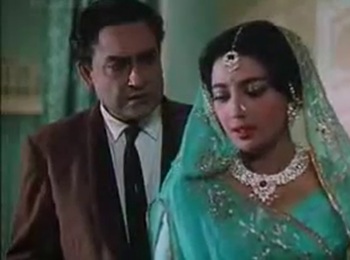 Mamta, directed by Asit Sen, is based on a novel titled Uttar Falguni by Nihar Ranjan Gupta. The film is a remake of Asit Sen's own Bengali film, Uttar Falguni (1963). Starring Ashok Kumar, Suchitra Sen and Dharmendra, it tells the story of Devyani, who is separated from her lover Manish and is forced to marry her late father’s debtor Rakhal, a vile character, who wants to pimp for her to earn money. She flees from home and lands up in a kotha, where she is renamed as Panna Bai, and where she delivers a female child. To save her child from her husband’s covetous eyes, she puts her in a residential school and keeps her identity secret. She cuts herself off from her child to prevent her past from affecting her future. Suchitra Sen, playing mother and daughter, acts very well. She was nominated for the Filmfare Best Actress Award for Mamta. I loved Ashok Kumar as Manish. Dharmendra also acts well.
Mamta, directed by Asit Sen, is based on a novel titled Uttar Falguni by Nihar Ranjan Gupta. The film is a remake of Asit Sen's own Bengali film, Uttar Falguni (1963). Starring Ashok Kumar, Suchitra Sen and Dharmendra, it tells the story of Devyani, who is separated from her lover Manish and is forced to marry her late father’s debtor Rakhal, a vile character, who wants to pimp for her to earn money. She flees from home and lands up in a kotha, where she is renamed as Panna Bai, and where she delivers a female child. To save her child from her husband’s covetous eyes, she puts her in a residential school and keeps her identity secret. She cuts herself off from her child to prevent her past from affecting her future. Suchitra Sen, playing mother and daughter, acts very well. She was nominated for the Filmfare Best Actress Award for Mamta. I loved Ashok Kumar as Manish. Dharmendra also acts well.
Music by Roshan and lyrics by Majrooh Sultanpuri add to the film’s appeal. Rahen na rahen hum sung by Lata Mangeshkar, and Chhupa lo yun dil mein pyar mera, her duet with Hemant Kumar, are my favourite songs.
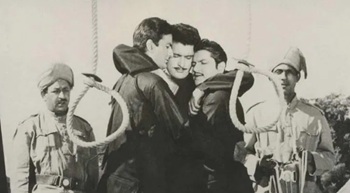 Shaheed is a biographical film on the life of freedom fighter Bhagat Singh, directed by S Ram Sharma, starring Manoj Kumar, Kamini Kaushal, and Pran in lead roles. The music was composed by Prem Dhawan, who used some songs written by freedom fighter Ram Prasad Bismil. Manoj Kumar spent several years preparing for his role, researching, visiting newspaper offices and libraries in Chennai while shooting for films there, and meeting Bhagat Singh's lawyer and many freedom fighters of the time.
Shaheed is a biographical film on the life of freedom fighter Bhagat Singh, directed by S Ram Sharma, starring Manoj Kumar, Kamini Kaushal, and Pran in lead roles. The music was composed by Prem Dhawan, who used some songs written by freedom fighter Ram Prasad Bismil. Manoj Kumar spent several years preparing for his role, researching, visiting newspaper offices and libraries in Chennai while shooting for films there, and meeting Bhagat Singh's lawyer and many freedom fighters of the time.
Shaheed did well at the box office, and at the 13th National Film Awards, Shaheed won the award for Best Feature Film in Hindi, and the Nargis Dutt Award for Best Feature Film on National Integration.
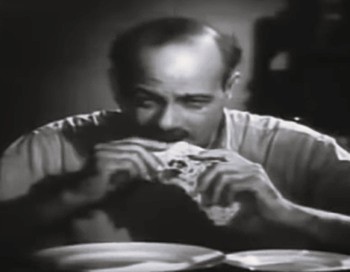 Chhoti Chhoti Baten is the only film written, produced, and directed by actor Motilal. It starred Motilal, Nadira, and Leela Mishra. The music of the film was by Anil Biswas. Motilal died before the film's release, and the film's post-production was overseen by singer Mukesh. The offbeat family drama earned critical acclaim but flopped at the box office.
Chhoti Chhoti Baten is the only film written, produced, and directed by actor Motilal. It starred Motilal, Nadira, and Leela Mishra. The music of the film was by Anil Biswas. Motilal died before the film's release, and the film's post-production was overseen by singer Mukesh. The offbeat family drama earned critical acclaim but flopped at the box office.
The film relates the story of a man who struggles to meet the demands of his avaricious family until he gets a large inheritance unexpectedly. He leaves home in search of peace after providing for their needs and lives in a village helping others in every way. By the time his repentant family rejoins him, he is wrongly accused of a scandal. Brokenhearted, he leaves the village never to return.
Chhoti Chhoti Baten was Anil Biswas's last film before retiring from Bollywood and joining All India Radio. Anil Biswas lost his elder son, his younger brother, and his childhood friend and brother-in-law, Pannalal Ghosh, within a short period, leaving him emotionally disturbed. Anil Biswas didn’t like the changes in Hindi film music in which Western influence was taking over, leaving no place for soft, soulful songs. He was getting very few offers, and the last straw was when some producers asked him to lift foreign tunes. He was not against Western music but believed in adding his own inputs to the tune. He had always wanted to create an orchestra of Indian instruments, and he saw a chance to do so in All India Radio. In March 1963, he joined All India Radio as the director of the national orchestra, leaving the Hindi film Industry forever.
At the 13th National Film Awards, Chhoti Chhoti Baten won the Certificate of Merit for the Third Best Feature Film. Motilal was posthumously awarded the Certificate of Merit for the Best Story.
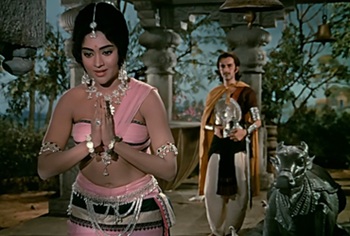 Amrapali, directed by Lekh Tandon, starring Sunil Dutt and Vyjayantimala, and music by Shankar–Jaikishan, is about the life of Amrapali, a courtesan of Vaishali in ancient India, and Ajatashatru, the emperor of the Magadha empire, who falls in love with her. She comes under the influence of Lord Buddha and renounces the world. It is based on old Pali and Buddhist traditions.
Amrapali, directed by Lekh Tandon, starring Sunil Dutt and Vyjayantimala, and music by Shankar–Jaikishan, is about the life of Amrapali, a courtesan of Vaishali in ancient India, and Ajatashatru, the emperor of the Magadha empire, who falls in love with her. She comes under the influence of Lord Buddha and renounces the world. It is based on old Pali and Buddhist traditions.
Good acting by Vyjayantimala and Sunil Dutt, and good direction make the film laudable. The film was not a commercial success, but is regarded as a classic of Hindi cinema. It is remembered for its dramatic war scenes, beautiful classic dances composed by Gopi Krishna, distinctive costumes by Bhanu Athayya, and music by Shankar-Jaikishan. All the songs were sung by Lata Mangeshkar. Tumhen yaad karte karte, and Tadap yeh din raat ki are well composed. My favourite song is Jao re jogi tum jao re. The film exploited Vyjayantimala's skills as a classical dancer to the hilt, particularly in the dance sequence Neel gagan ki chhaon mein, with Vyjayantimala in a flaming orange outfit. It was a well-defined, choreographed, and executed classical dance, with graceful movements, gorgeous costumes, and footwork.
05-Jul-2025
More by : Ramarao Annavarapu

|
Nice as always sir. Thank you very much. |

|
Great memories as always ! |